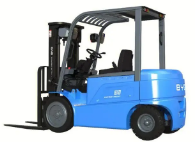News Details
The stability of electric forklifts
The stability of an electric forklift refers to its ability to avoid overturning and skidding during operation. Stability can be divided into two types: longitudinal stability and lateral stability, which are directly related to factors such as vehicle speed, road conditions, wheelbase, center of gravity position, and steering speed.
Firstly, longitudinal stability refers to the ability of a forklift to maintain balance when going uphill or downhill. When an electric forklift is going uphill or downhill in the opposite direction, as long as emergency braking is not used, it is generally not easy to lose longitudinal stability, which is determined by the maximum climbing slope of the forklift design. However, when a heavy-duty forklift goes uphill or downhill in the opposite direction, or an unloaded forklift goes downhill in the opposite direction, it is easy to lose longitudinal stability and capsize. Therefore, heavy-duty forklifts should move forward when going uphill and backward when going downhill, and emergency braking should be avoided on slopes. In addition, when it is necessary to lift the forklift, the gantry must be in the rearward tilt position to prevent the forklift from tipping forward.

Secondly, lateral stability refers to the ability of a forklift to maintain balance while driving. Forklifts exert adhesion on the road surface through their own weight to maintain stability. At the same time, forklifts may also be subjected to a lateral force, known as lateral force. When the lateral force exceeds the lateral stability capability of the forklift, it will cause the forklift to slide or tip over. The main factors that cause lateral force on electric forklifts are as follows: firstly, excessive lateral tilt of the road surface during operation; The second is driving too fast or turning too quickly when turning; Thirdly, the braking force of the left and right wheels is different; Fourthly, the adhesion coefficient of the road surface under the wheels is different; The fifth issue is cargo imbalance and high center of gravity.
The stability of electric forklifts is crucial for ensuring the safety of operators and cargo. In order to ensure the stability of forklifts, operators should pay attention to following relevant operating procedures and safety requirements, such as correctly using brakes, controlling vehicle speed, and avoiding overloading. In addition, regular inspection and maintenance of the working condition of forklifts are also important measures to ensure stability. Only by maintaining the stability of forklifts can work efficiency be improved and workplace safety be ensured.

